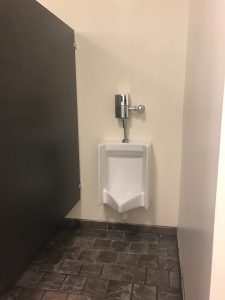
The sign reminding girls to clean up their hair. It reveals the tendency and ideal that women take care of their long hair.
Our group examined various gendered and gender neutral bathrooms in an effort to discover how their materiality reflects the perceptions and ideals of our society. In the dormitory, we observed little contrast between the men’s and women’s bathrooms. A few notable gender specific objects included the reminder on the mirror asking girls to clean up their hair after a shower. This might reflect the social perception or the practical tendency of girls having and being responsible for their long hair.

The feminine hygiene unit. The sign forbids us from throwing anything other than hygiene wastes. Therefore it serves as an effective gender indicator.
Another gender indicator was the feminine hygiene unit placed in each stall. They are for women to dispose of their feminine hygiene products such as tampons. Since men do not use such products, we concluded that the hygiene unit is particularly indicative of gender.

Emory policy stating equal opportunities for all individuals.
Despite what was mentioned above, the two gendered bathrooms looked fairly alike. It would be hard to distinguish which is which at first glance. By digging deeper into the rationale for such similar designs, we looked up several policies on the Emory Policies and Procedures website. The Equal Opportunity Policy claims that “Emory provides equal opportunities to all individuals regardless of gender.” It is also stated that Emory does not support stereotypes. Therefore, the similar design and bathroom essentials reflect the effort made by Emory to provide equal opportunities to every student, as well as its rejection of gender stereotypes prevalent among society.

Men’s urinal in the Business School. A way to save water and space.
However, in the Goizueta Business School, we did find an interesting discrepancy with our previous conclusion. The urinals in the men’s bathroom clearly distinguish gender and are incompatible with the inclusive environment Emory intends to foster. We believed that Emory did so in order to save on utility costs. Urinals use less water than toilets, the small size of which also saves much space. Personally, I see this discrepancy as a result of the trade-off between efficiency and equality. Achieving one to some extent sacrifices the other.

Kaldi’s gender neutral bathroom. Large in size, nice-looking and convenient.
We also found out the society’s expectation for women to be a caring mother, as can be seen from the baby-changing station in the restaurant bathroom. We then brought up the question whether there is a need for gender-specific bathrooms. Overall, this was a very informative experience. Our group examined the differences of the materiality under multiple settings, and explored the ideals embedded inside such differences.